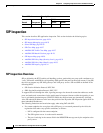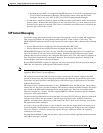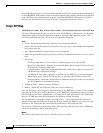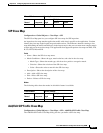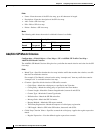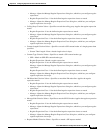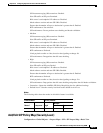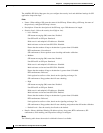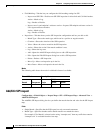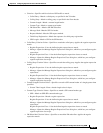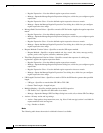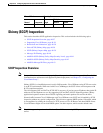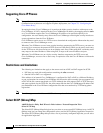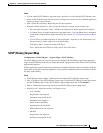
48-32
Cisco ASA 5500 Series Configuration Guide using ASDM
Chapter 48 Configuring Inspection for Voice and Video Protocols
SIP Inspection
The Add/Edit SIP Policy Map pane lets you configure the security level and additional settings for SIP
application inspection maps.
Fields
• Name—When adding a SIP, enter the name of the SIP map. When editing a SIP map, the name of
the previously configured SIP map is shown.
• Description—Enter the description of the SIP map, up to 200 characters in length.
• Security Level—Select the security level (high or low).
–
Low—Default.
SIP instant messaging (IM) extensions: Enabled.
Non-SIP traffic on SIP port: Permitted.
Hide server’s and endpoint’s IP addresses: Disabled.
Mask software version and non-SIP URIs: Disabled.
Ensure that the number of hops to destination is greater than 0: Enabled.
RTP conformance: Not enforced.
SIP conformance: Do not perform state checking and header validation.
–
Medium
SIP instant messaging (IM) extensions: Enabled.
Non-SIP traffic on SIP port: Permitted.
Hide server’s and endpoint’s IP addresses: Disabled.
Mask software version and non-SIP URIs: Disabled.
Ensure that the number of hops to destination is greater than 0: Enabled.
RTP conformance: Enforced.
Limit payload to audio or video, based on the signaling exchange: No
SIP conformance: Drop packets that fail state checking.
–
High
SIP instant messaging (IM) extensions: Enabled.
Non-SIP traffic on SIP port: Denied.
Hide server’s and endpoint’s IP addresses: Disabled.
Mask software version and non-SIP URIs: Enabled.
Ensure that the number of hops to destination is greater than 0: Enabled.
RTP conformance: Enforced.
Limit payload to audio or video, based on the signaling exchange: Yes
SIP conformance: Drop packets that fail state checking and packets that fail header validation.
–
Default Level—Sets the security level back to the default.
• Details—Shows additional filtering, IP address privacy, hop count, RTP conformance, SIP
conformance, field masking, and inspections settings to configure.
Modes
The following table shows the modes in which this feature is available:



